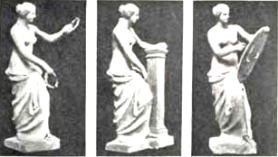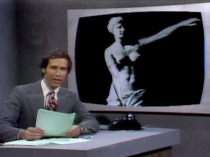

...είναι ένα από τα πιο γνωστά γλυπτά στον κόσμο, θεωρείται συνώνυμο της ομορφιάς και ο κόσμος συρρέει στο Μουσείο του Λούβρου για να τη δει.
Τι κοιτούσε ωστόσο με το ήρεμο βλέμμα της- που εμείς δεν βλέπουμε αφού
τα χέρια της αποκόπηκαν από το σώμα της- είναι ένα ερώτημα που έχει επιχειρηθεί πολλές φορές να απαντηθεί.
Υποστηρίχθηκε πως στο άγαλμά της που βρέθηκε στη Μήλο,η θεά Αφροδίτη κρατά έναν καθρέφτη, ή ένα δόρυ ή ένα μήλο, αλλά η θεωρία μιας Αμερικανίδας συγγραφέα- με τη βοήθεια ενός καλλιτέχνη τρισδιάστατων εκτυπώσεων- έρχεται να επιβεβαιώσει τη θεωρία που είχε πρωτοδιατυπωθεί πολλές δεκαετίες πριν, σύμφωνα με την οποία η θεά έγνεθε μαλλί!
Κατόπιν αιτήματος της συγγραφέως Virginia Postrel που έγραψε το βιβλίο «The Power of Glamour: Longing and the Art of Visual Persuasion»,
ο καλλιτέχνης Cosmo Wenman έκανε τρισδιάστατη αναπαράσταση για να
δείξει πως είναι πιθανό, σύμφωνα με την πόζα του γλυπτού, η Αφροδίτη να έγνεθε, δραστηριότητα συνηθισμένη μεταξύ των γυναικών που παρείχαν… ερωτικές υπηρεσίες, την ώρα που περίμεναν τους πελάτες τους.
Να κρατούσε δηλαδή ρόκα και μαλλί.
Ο καλλιτέχνης εξηγεί πως το κουβάρι στη ρόκα δεν μπορεί να ήταν
φτιαγμένο από μάρμαρο γιατί θα ήταν πολύ βαρύ κι έτσι επέλεξε να το κάνει χρυσό, καθώς θα μπορούσε να είναι από βαμμένο ξύλο ή να αποτελείται από
μια κενή επιχρυσωμένη μπρούτζινη σφαίρα. Με την ίδια λογική εκτίμησε πως
το νήμα δεν θα ήταν κανονικό νήμα κι έτσι χρησιμοποίησε μια χρυσή αλυσίδα.
Και ιδού το αποτέλεσμα...
~*~

Cosmo Wenman
Venus de Milo Spinning Thread
This Slate story,
What Was the Venus de Milo Doing With Her Arms?
by Virginia Postrel describes a fun project she hired me to work on–designing and 3D printing a restoration of Venus de Milo’s missing arms, showing her holding tools, spinning thread in the ancient technique.
Venus de Milo Spinning Thread
This Slate story,
What Was the Venus de Milo Doing With Her Arms?
by Virginia Postrel describes a fun project she hired me to work on–designing and 3D printing a restoration of Venus de Milo’s missing arms, showing her holding tools, spinning thread in the ancient technique.
I started with my own 3D capture of Venus de Milo–the most accurate 3D model of Venus de Milo in existence, which I made from an 1850 plaster cast by the Louvre’s own atelier that is now housed at the Skulpturhalle Basel museum.

-Woman_spinning_MAR_Palermo_NI2149
*The pose and tools were modeled after ancient Greek painted vases
and a few diagrams by archaeologist Elizabeth Wayland Barber and others,outlining this theory of Venus’ original design.
*In thread spinning,the upper tool, the distaff,holds a mass of rough wool, and the lower tool, the spindle, is spun to twist and gather the thread into
a finer filament.
*I figured that the ball of wool on the distaff would be too heavy to have
been made in marble, so I painted it gold as though it were wood, or a hollow, gilded bronze sphere. The thread would likely not have been wool in an actual life-sized statue,so I used a gold chain instead,and carried the gold motif down to the gathered thread on the spindle.
*This gilding has a couple effects: it creates a physically plausible design,
and draws the eye away from the novelty of the reconstructed arms,
putting the viewer’s focus on the tools and the activity, where it would
have been intended.
a finer filament.
*I figured that the ball of wool on the distaff would be too heavy to have
been made in marble, so I painted it gold as though it were wood, or a hollow, gilded bronze sphere. The thread would likely not have been wool in an actual life-sized statue,so I used a gold chain instead,and carried the gold motif down to the gathered thread on the spindle.
*This gilding has a couple effects: it creates a physically plausible design,
and draws the eye away from the novelty of the reconstructed arms,
putting the viewer’s focus on the tools and the activity, where it would
have been intended.

*The gold is also a sleight of hand, in that it emphasises the question of how the tools and wool would have been presented–marble, gold, bronze, painted wood? Notice how we’re not talking about the new arms anymore?
(Here’s a theory, though: maybe she lost her arms because some dope did, in fact, put a 30-pound marble ball on the top of the distaff, and 20 pounds of extra weight from a solid marble spindle hanging on her right arm.)
*There are several other theories about Venus’ original arms. Here she is next to Ares; holding laurels; holding an apple; holding a shield; spinning thread. Some theories are more convincing than others.




*I do like the version with her standing next to Ares, but mainly because I have also 3D captured that particular speculative reconstruction Ares’ magnificent headdress
*Most of these other conjectures look too much like after-the-fact attempts to work out some pose that makes sense of the awkward positions indicated by what little remains of Venus’ arms.
*Spinning thread seems to me to be the only activity that actually requires this odd, specific pose. It is also one of the few that agrees with the drawing of her made by Jean-Baptiste-Joseph Debay in 1821, shortly after her discovery, which shows much more of her left upper arm still intact.
*Spinning thread seems to me to be the only activity that actually requires this odd, specific pose. It is also one of the few that agrees with the drawing of her made by Jean-Baptiste-Joseph Debay in 1821, shortly after her discovery, which shows much more of her left upper arm still intact.

*There are accounts of a marble hand holding an apple being found near Venus. But it is described as being of a markedly lower quality than the rest of the sculpture. Also, my understanding is that the person who first bought Venus on Melos was desperate to sell it, and to present it in the most fashionable light possible–meaning that the contemporaneous accounts of its discovery are not necessarily reliable. (And having just recently read Chasing Aphrodite, it seems to me that “contemporaneous” records of discovery might very well be the least reliable products of the antiquities trade.) In fact, the one thing we know with certainty about the Venus de Milo is that she’s not Venus. She may be Aphrodite, but even that is not certain.
*All the firm-but-citation-free assertions in Wikipedia notwithstanding,the Louvre itself seems to discount equally all theories about her identity and what she was holding, possibly preferring to preserve Venus’ enigmatic nature. Which makes sense, Camille Paglia explains: “Supreme western works of art, like Oedipus Rex and Hamlet, preserve their indeterminacy through all interpretation. They are morally ungraspable. Even the Venus de Milo gained everything by losing her arms.”
*I was able to do this reconstruction because I had my original 3D capture of the Venus de Milo–which I’ve made freely available to anyone in the world.
It’s a great example of the kind of adaptations people would be able to do if more museums made their 3D data available to the public.
It’s a great example of the kind of adaptations people would be able to do if more museums made their 3D data available to the public.
*But by far the most important take-away from this project is in the
Slate story’s large, bold-text pull-quote about me: “I hired him…”
You can too!
Slate story’s large, bold-text pull-quote about me: “I hired him…”
You can too!
Posted on May 4, 2015 by cosmowenman
~*~
The Power of Glamour:
Longing and the Art of Visual Persuasion
Longing and the Art of Visual Persuasion
by Virginia Postrel (Goodreads Author)
In provocative detail with more than one hundred illustrations, critically acclaimed author Virginia Postrel separates glamour from glitz, revealing what qualities make a person, an object, a setting, or an experience glamorous.
In provocative detail with more than one hundred illustrations, critically acclaimed author Virginia Postrel separates glamour from glitz, revealing what qualities make a person, an object, a setting, or an experience glamorous.
What is it that creates that pleasurable pang of desire—the feeling of “if only”? If only I could wear those clothes, belong to that group, drive that car, live in that house, be (or be with) that person? Postrel identifies the three essential elements in all forms of glamour and explains how they work to create a distinctive sensation of projection and yearning.
The Power of Glamour is the very first book to explain what glamour really is—not just style or a personal quality but a phenomenon that reveals our inner lives and shapes our decisions, large and small. By embodying the promise of
a different and better self in different and better circumstances, glamour stokes ambition and nurtures hope, even as it fosters sometimes-dangerous illusions.
a different and better self in different and better circumstances, glamour stokes ambition and nurtures hope, even as it fosters sometimes-dangerous illusions.
From vacation brochures to military recruiting ads, from the Chrysler Building
to the iPad, from political utopias to action heroines, Postrel argues that glamour is a seductive cultural force. Its magic stretches beyond the stereotypical spheres of fashion or film, influencing our decisions about what to buy, where to live, which careers to pursue, where to invest, and how to vote.
to the iPad, from political utopias to action heroines, Postrel argues that glamour is a seductive cultural force. Its magic stretches beyond the stereotypical spheres of fashion or film, influencing our decisions about what to buy, where to live, which careers to pursue, where to invest, and how to vote.
The result is myth shattering: a revelatory theory that explains how glamour became a powerful form of nonverbal persuasion, one that taps into our most secret dreams and deepest yearnings to influence our everyday choices.
Virginia Postrel is a columnist for Bloomberg View and has been a regular contributor to The Wall Street Journal, The Atlantic, The New York Times,
and Forbes. Formerly the editor of Reason magazine,she is the author of The Substance of Style and The Future and Its Enemies. She teaches a special seminar on glamour in the Branding program at the School of Visual Arts in
New York. She lives in Los Angeles.
and Forbes. Formerly the editor of Reason magazine,she is the author of The Substance of Style and The Future and Its Enemies. She teaches a special seminar on glamour in the Branding program at the School of Visual Arts in
New York. She lives in Los Angeles.

Δεν υπάρχουν σχόλια:
Δημοσίευση σχολίου